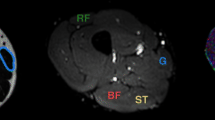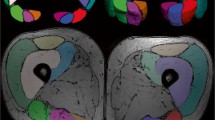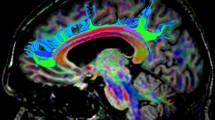Abstract
Objectives
To consider the tract-based analysis of DTI parameters in human muscle by assessing different fiber tracking stop criteria settings on diffusion parameters.
Materials and methods
30 healthy volunteers underwent a 3 T MRI. Diffusion-weighted images were acquired to perform DTI and fiber tracking analysis for six thigh muscles. Whole thigh muscles were evaluated by fiber tractography using different fiber tracking stop parameters [FA (0.01–0.15) to (0.4–0.99); angle 10°–30°, step size 0.75 mm, 1.5 mm, 3 mm]. Diffusion and tractography-derived parameters per stop criterion were compared using a repeated measure ANOVA including Bonferroni-corrected post hoc tests.
Results
We found significant differences in all examined diffusion parameters between different stop criteria (main effect p < 0.001). We showed different influence of tracking parameters on diffusion parameters in examined muscles (main effect p ≤ 0.001).
Conclusions
Statistically significant differences in fiber tracking results using different stop criteria were shown. Fiber tracking stop criteria do have an important influence on study results and should be considered in the development of study protocols and comparison of studies. We recommend a FA minimum of 0.10 and a step size lower than voxel size, e.g., a half with a constant ratio between step size and angle of 10°/mm.






Similar content being viewed by others
References
Oudeman J, Nederveen AJ, Strijkers GJ et al (2016) Techniques and applications of skeletal muscle diffusion tensor imaging: a review. J Magn Reson Imaging 43(4):773–788. https://doi.org/10.1002/jmri.25016
Berry DB, Regner B, Galinsky V et al (2018) Relationships between tissue microstructure and the diffusion tensor in simulated skeletal muscle. Magn Reson Med 80(1):317–329. https://doi.org/10.1002/mrm.26993
Ha D-H, Choi S, Kang E-J et al (2015) Diffusion tensor imaging and T2 mapping in early denervated skeletal muscle in rats. J Magn Reson Imaging 42(3):617–623. https://doi.org/10.1002/jmri.24818
Ai T, Yu K, Gao L et al (2014) Diffusion tensor imaging in evaluation of thigh muscles in patients with polymyositis and dermatomyositis. Br J Radiol 87(1043):20140261. https://doi.org/10.1259/bjr.20140261
Edalati M, Hastings MK, Sorensen CJ et al (2018) Diffusion tensor imaging of the calf muscles in subjects with and without diabetes mellitus. J Magn Reson Imaging. https://doi.org/10.1002/jmri.26286
Giraudo C, Motyka S, Weber M et al (2018) Normalized STEAM-based diffusion tensor imaging provides a robust assessment of muscle tears in football players: preliminary results of a new approach to evaluate muscle injuries. Eur Radiol 28(7):2882–2889. https://doi.org/10.1007/s00330-017-5218-9
Zaraiskaya T, Kumbhare D, Noseworthy MD (2006) Diffusion tensor imaging in evaluation of human skeletal muscle injury. J Magn Reson Imaging 24(2):402–408. https://doi.org/10.1002/jmri.20651
Hooijmans MT, Damon BM, Froeling M et al (2015) Evaluation of skeletal muscle DTI in patients with duchenne muscular dystrophy. NMR Biomed 28(11):1589–1597. https://doi.org/10.1002/nbm.3427
Li GD, Liang YY, Xu P et al (2016) Diffusion-tensor imaging of thigh muscles in duchenne muscular dystrophy: correlation of apparent diffusion coefficient and fractional anisotropy values with fatty infiltration. AJR Am J Roentgenol 206(4):867–870. https://doi.org/10.2214/AJR.15.15028
Froeling M, Oudeman J, Strijkers GJ et al (2015) Muscle changes detected with diffusion-tensor imaging after long-distance running. Radiology 274(2):548–562. https://doi.org/10.1148/radiol.14140702
Sigmund EE, Baete SH, Luo T et al (2018) MRI assessment of the thigh musculature in dermatomyositis and healthy subjects using diffusion tensor imaging, intravoxel incoherent motion and dynamic DTI. Eur Radiol. https://doi.org/10.1007/s00330-018-5458-3
Arrigoni F, de Luca A, Velardo D et al (2018) Multiparametric quantitative MRI assessment of thigh muscles in limb-girdle muscular dystrophy 2A and 2B. Muscle Nerve 58(4):550–558. https://doi.org/10.1002/mus.26189
Froeling M, Nederveen AJ, Nicolay K et al (2013) DTI of human skeletal muscle: the effects of diffusion encoding parameters, signal-to-noise ratio and T2 on tensor indices and fiber tracts. NMR Biomed 26(11):1339–1352. https://doi.org/10.1002/nbm.2959
Damon BM, Ding Z, Anderson AW et al (2002) Validation of diffusion tensor MRI-based muscle fiber tracking. Magn Reson Med 48(1):97–104. https://doi.org/10.1002/mrm.10198
Budzik J-F, Balbi V, Verclytte S et al (2014) Diffusion tensor imaging in musculoskeletal disorders. Radiographics 34(3):E56–72. https://doi.org/10.1148/rg.343125062
Heemskerk AM, Sinha TK, Wilson KJ et al (2009) Quantitative assessment of DTI-based muscle fiber tracking and optimal tracking parameters. Magn Reson Med 61(2):467–472. https://doi.org/10.1002/mrm.21819
Damon BM, Buck AKW, Ding Z (2011) Diffusion-tensor MRI based skeletal muscle fiber tracking. Imaging Med 3(6):675–687. https://doi.org/10.2217/iim.11.60
Budzik JF, Le Thuc V, Demondion X et al (2007) In vivo MR tractography of thigh muscles using diffusion imaging: initial results. Eur Radiol 17(12):3079–3085. https://doi.org/10.1007/s00330-007-0713-z
Schlaffke L, Rehmann R, Froeling M et al (2017) Diffusion tensor imaging of the human calf: variation of inter- and intramuscle-specific diffusion parameters. J Magn Reson Imaging 46(4):1137–1148. https://doi.org/10.1002/jmri.25650
Tax CMW, Otte WM, Viergever MA et al (2015) REKINDLE: robust extraction of kurtosis INDices with linear estimation. Magn Reson Med 73(2):794–808. https://doi.org/10.1002/mrm.25165
Leemans A, Jeurissen B, Sijbers J, Jones DK (2009) ExploreDTI: a graphical toolbox for processing, analyzing, and visualizing diffusion MR data. Proc Int Soc Mag Reson Med 17:3537
Froeling M, Tax CMW, Vos SB et al (2017) "MASSIVE" brain dataset: multiple acquisitions for standardization of structural imaging validation and evaluation. Magn Reson Med 77(5):1797–1809. https://doi.org/10.1002/mrm.26259
Basser PJ, Pajevic S, Pierpaoli C et al (2000) In vivo fiber tractography using DT-MRI data. Magn Reson Med 44(4):625–632. https://doi.org/10.1002/1522-2594(200010)44:4%3c625:AID-MRM17%3e3.0.CO;2-O
Leemans A, Jones DK (2009) The B-matrix must be rotated when correcting for subject motion in DTI data. Magn Reson Med 61(6):1336–1349. https://doi.org/10.1002/mrm.21890
Giraudo C, Motyka S, Weber M et al (2018) Diffusion tensor imaging of healthy skeletal muscles: a comparison between 7 T and 3 T. Investig Radiol. https://doi.org/10.1097/RLI.0000000000000508
Mazzoli V, Oudeman J, Nicolay K et al (2016) Assessment of passive muscle elongation using diffusion tensor MRI: correlation between fiber length and diffusion coefficients. NMR Biomed 29(12):1813–1824. https://doi.org/10.1002/nbm.3661
Ponrartana S, Ramos-Platt L, Wren TAL et al (2015) Effectiveness of diffusion tensor imaging in assessing disease severity in Duchenne muscular dystrophy: preliminary study. Pediatr Radiol 45(4):582–589. https://doi.org/10.1007/s00247-014-3187-6
Froeling M, Oudeman J, van den Berg S et al (2010) Reproducibility of diffusion tensor imaging in human forearm muscles at 3.0 T in a clinical setting. Magn Reson Med 64(4):1182–1190. https://doi.org/10.1002/mrm.22477
Kälin PS, Huber FA, Hamie QM et al (2018) Quantitative MRI of visually intact rotator cuff muscles by multiecho dixon-based fat quantification and diffusion tensor imaging. J Magn Reson Imaging. https://doi.org/10.1002/jmri.26223
Zijta FM, Lakeman MME, Froeling M et al (2012) Evaluation of the female pelvic floor in pelvic organ prolapse using 3.0-Tesla diffusion tensor imaging and fibre tractography. Eur Radiol 22(12):2806–2813. https://doi.org/10.1007/s00330-012-2548-5
Zifan A, Reisert M, Sinha S et al (2018) Connectivity of the superficial muscles of the human perineum: a diffusion tensor imaging-based global tractography study. Sci Rep 8(1):17867. https://doi.org/10.1038/s41598-018-36099-4
Rousset P, Delmas V, Buy J-N et al (2012) In vivo visualization of the levator ani muscle subdivisions using MR fiber tractography with diffusion tensor imaging. J Anat 221(3):221–228. https://doi.org/10.1111/j.1469-7580.2012.01538.x
Gaige TA, Benner T, Wang R et al (2007) Three dimensional myoarchitecture of the human tongue determined in vivo by diffusion tensor imaging with tractography. J Magn Reson Imaging 26(3):654–661. https://doi.org/10.1002/jmri.21022
Sigmund EE, Novikov DS, Sui D et al (2014) Time-dependent diffusion in skeletal muscle with the random permeable barrier model (RPBM): application to normal controls and chronic exertional compartment syndrome patients. NMR Biomed 27(5):519–528. https://doi.org/10.1002/nbm.3087
Kermarrec E, Budzik J-F, Khalil C et al (2010) In vivo diffusion tensor imaging and tractography of human thigh muscles in healthy subjects. AJR Am J Roentgenol 195(5):W352–W356. https://doi.org/10.2214/AJR.09.3368
Fouré A, Ogier AC, Le Troter A et al (2018) Diffusion properties and 3d architecture of human lower leg muscles assessed with ultra-high-field-strength diffusion-tensor MR imaging and tractography: reproducibility and sensitivity to sex difference and intramuscular variability. Radiology 287(2):592–607. https://doi.org/10.1148/radiol.2017171330
Kan JH, Heemskerk AM, Ding Z et al (2009) DTI-based muscle fiber tracking of the quadriceps mechanism in lateral patellar dislocation. J Magn Reson Imaging 29(3):663–670. https://doi.org/10.1002/jmri.21687
Côté M-A, Girard G, Boré A et al (2013) Tractometer: towards validation of tractography pipelines. Med Image Anal 17(7):844–857. https://doi.org/10.1016/j.media.2013.03.009
Tournier J-D, Calamante F, Connelly A (2012) MRtrix: diffusion tractography in crossing fiber regions. Int J Imaging Syst Technol 22(1):53–66. https://doi.org/10.1002/ima.22005
Jeon T, Fung MM, Koch KM et al (2018) Peripheral nerve diffusion tensor imaging: overview, pitfalls, and future directions. J Magn Reson Imaging 47(5):1171–1189. https://doi.org/10.1002/jmri.25876
Kronlage M, Schwehr V, Schwarz D et al (2018) Peripheral nerve diffusion tensor imaging (DTI): normal values and demographic determinants in a cohort of 60 healthy individuals. Eur Radiol 28(5):1801–1808. https://doi.org/10.1007/s00330-017-5134-z
Manenti G, Capuani S, Fanucci E et al (2013) Diffusion tensor imaging and magnetic resonance spectroscopy assessment of cancellous bone quality in femoral neck of healthy, osteopenic and osteoporotic subjects at 3T: preliminary experience. Bone 55(1):7–15. https://doi.org/10.1016/j.bone.2013.03.004
Damon BM, Froeling M, Buck AKW et al (2017) Skeletal muscle diffusion tensor-MRI fiber tracking: rationale, data acquisition and analysis methods, applications and future directions. NMR Biomed. https://doi.org/10.1002/nbm.3563
Wickiewitz TL (1983) Architecture of human lower limb. Clin Orthop Relat Res 173:276–283
Lieber RL, Fridén J (2001) Clinical significance of skeletal muscle architecture. Clin Orthop Relat Res 383:140–151. https://doi.org/10.1097/00003086-200102000-00016
Lieber RL, Fridén J (2000) Functional and clinical significance of skeletal muscle architecture. Muscle Nerve 23(11):1647–1666. https://doi.org/10.1002/1097-4598(200011)23:11%3c1647:AID-MUS1%3e3.0.CO;2-M
Okamoto Y (2008) Fractional anisotropy values of calf muscles in normative state after exercise: preliminary results. Magn Reson Med 7(3):157–162
Charles JP, Moon C, Anderst WJ (2019) Determining subject-specific lower-limb muscle architecture data for musculoskeletal models using diffusion tensor imaging. ASME J Biomech Eng 141(6):060905. https://doi.org/10.1115/1.4040946
Oudeman J, Mazzoli V, Marra MA et al (2016) A novel diffusion-tensor MRI approach for skeletal muscle fascicle length measurements. Physiol Rep. https://doi.org/10.14814/phy2.13012
Bolsterlee B, D'Souza A, Herbert RD (2019) Reliability and robustness of muscle architecture measurements obtained using diffusion tensor imaging with anatomically constrained tractography. J Biomech 86:71–78. https://doi.org/10.1016/j.jbiomech.2019.01.043
Acknowledgements
We thank Philips Germany for continuous scientific support and specifically Dr. Burkhard Mädler for valuable discussion. JF, LS and MT received funding from the Deutsche Forschungsgemeinschaft Project number 122679504 SFB874 (TP-A1 to MT and JF, TP-A5 to LS).
Author information
Authors and Affiliations
Contributions
JF: Study conception and design, acquisition of data, analysis and interpretation of data, drafting of manuscript. RR: Acquisition of data, critical revision. MF: Analysis and interpretation of data, critical revision. MV: Critical revision. MT: Study conception and design, critical revision. LS: Study conception and design, acquisition of data, analysis and interpretation of data, critical revision.
Corresponding author
Ethics declarations
Conflict of interest
The authors declare that they have no conflict of interest.
Ethical approval
Study protocol was approved by local ethics committee.
Informed consent
Voluntary informed consent was obtained from all participants.
Additional information
Publisher's Note
Springer Nature remains neutral with regard to jurisdictional claims in published maps and institutional affiliations.
Electronic supplementary material
Below is the link to the electronic supplementary material.
Rights and permissions
About this article
Cite this article
Forsting, J., Rehmann, R., Froeling, M. et al. Diffusion tensor imaging of the human thigh: consideration of DTI-based fiber tracking stop criteria. Magn Reson Mater Phy 33, 343–355 (2020). https://doi.org/10.1007/s10334-019-00791-x
Received:
Revised:
Accepted:
Published:
Issue Date:
DOI: https://doi.org/10.1007/s10334-019-00791-x




